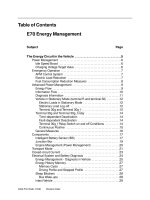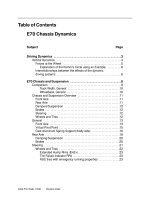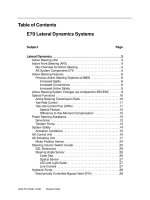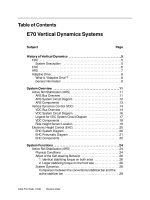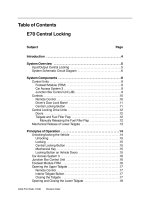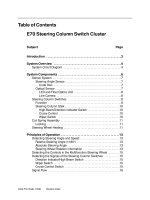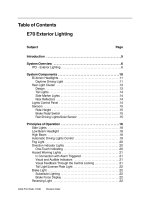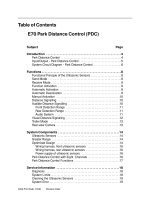Xe ô tô BMW X5 E70 SM 04c_E70 Vertical Dynamics Systems
Bạn đang xem bản rút gọn của tài liệu. Xem và tải ngay bản đầy đủ của tài liệu tại đây (1.47 MB, 76 trang )
Initial P
rint
Dat
e: 10/06
Table of Contents
Subject Page
History of Vertical Dynamics . . . . . . . . . . . . . . . . . . . . . . . . . . . . . . . . . . .5
EDC . . . . . . . . . . . . . . . . . . . . . . . . . . . . . . . . . . . . . . . . . . . . . . . . . . . . . . . . . .5
System Description . . . . . . . . . . . . . . . . . . . . . . . . . . . . . . . . . . . . . . . . . .5
EHC . . . . . . . . . . . . . . . . . . . . . . . . . . . . . . . . . . . . . . . . . . . . . . . . . . . . . . . . . .6
ARS . . . . . . . . . . . . . . . . . . . . . . . . . . . . . . . . . . . . . . . . . . . . . . . . . . . . . . . . . . .7
Adaptive Drive . . . . . . . . . . . . . . . . . . . . . . . . . . . . . . . . . . . . . . . . . . . . . . . . . .8
What is "Adaptive Drive"? . . . . . . . . . . . . . . . . . . . . . . . . . . . . . . . . . . . . .8
General Information . . . . . . . . . . . . . . . . . . . . . . . . . . . . . . . . . . . . . . . . . .8
System Overview . . . . . . . . . . . . . . . . . . . . . . . . . . . . . . . . . . . . . . . . . . . .11
Active Roll Stabilization (ARS) . . . . . . . . . . . . . . . . . . . . . . . . . . . . . . . . . . .11
ARS Bus Overview . . . . . . . . . . . . . . . . . . . . . . . . . . . . . . . . . . . . . . . . . .11
ARS System Circuit Diagram . . . . . . . . . . . . . . . . . . . . . . . . . . . . . . . . .12
ARS Components . . . . . . . . . . . . . . . . . . . . . . . . . . . . . . . . . . . . . . . . . .13
Vertical Dynamics Control (VDC) . . . . . . . . . . . . . . . . . . . . . . . . . . . . . . . .14
VDC Bus Overview . . . . . . . . . . . . . . . . . . . . . . . . . . . . . . . . . . . . . . . . . .14
VDC System Circuit Diagram . . . . . . . . . . . . . . . . . . . . . . . . . . . . . . . . .16
Legend for VDC System Circuit Diagram . . . . . . . . . . . . . . . . . . . . . .17
VDC Components . . . . . . . . . . . . . . . . . . . . . . . . . . . . . . . . . . . . . . . . . .18
Ride Height Sensor Location . . . . . . . . . . . . . . . . . . . . . . . . . . . . . . . . .19
Electronic Height Control (EHC) . . . . . . . . . . . . . . . . . . . . . . . . . . . . . . . . .20
EHC System Diagram . . . . . . . . . . . . . . . . . . . . . . . . . . . . . . . . . . . . . . .20
EHC Pneumatic Diagram . . . . . . . . . . . . . . . . . . . . . . . . . . . . . . . . . . . .21
EHC Components . . . . . . . . . . . . . . . . . . . . . . . . . . . . . . . . . . . . . . . . . .22
System Functions . . . . . . . . . . . . . . . . . . . . . . . . . . . . . . . . . . . . . . . . . . . .24
Activ
e Roll Stabilization (ARS) . . . . . . . . . . . . . . . . . . . . . . . . . . . . . . . . . . .24
Physical Conditions . . . . . . . . . . . . . . . . . . . . . . . . . . . . . . . . . . . . . . . . .24
Affect of the Self-steering Behavior . . . . . . . . . . . . . . . . . . . . . . . . . . .26
1. Identical stabilizing torque on both axles . . . . . . . . . . . . . . . . . .26
2. Larger stabilizing torque on the front axle . . . . . . . . . . . . . . . . . .26
System Dynamics . . . . . . . . . . . . . . . . . . . . . . . . . . . . . . . . . . . . . . . . . . .28
Comparison between the conventional stabilizer bar and the
active stabilizer bar . . . . . . . . . . . . . . . . . . . . . . . . . . . . . . . . . . . . . . .28
E70 Vertical Dynamics Systems
R
e
vision Dat
e:
Subject Page
Operating States . . . . . . . . . . . . . . . . . . . . . . . . . . . . . . . . . . . . . . . . . . . .29
Straight-ahead Travel . . . . . . . . . . . . . . . . . . . . . . . . . . . . . . . . . . . . .29
Cornering . . . . . . . . . . . . . . . . . . . . . . . . . . . . . . . . . . . . . . . . . . . . . . .29
Restricted Function . . . . . . . . . . . . . . . . . . . . . . . . . . . . . . . . . . . . . .29
Hydraulic Circuit, Normal Function . . . . . . . . . . . . . . . . . . . . . . . . . . . .30
Hydraulic Circuit, Fail-safe Function . . . . . . . . . . . . . . . . . . . . . . . . . . .31
Vertical Dynamics Control (VDC) . . . . . . . . . . . . . . . . . . . . . . . . . . . . . . . .32
General Information . . . . . . . . . . . . . . . . . . . . . . . . . . . . . . . . . . . . . . . . .32
Objectives of the VDC System . . . . . . . . . . . . . . . . . . . . . . . . . . . . . . .34
System Network . . . . . . . . . . . . . . . . . . . . . . . . . . . . . . . . . . . . . . . . .35
Electronic Height Control (EHC) . . . . . . . . . . . . . . . . . . . . . . . . . . . . . . . . .36
Air Spring Functions . . . . . . . . . . . . . . . . . . . . . . . . . . . . . . . . . . . . . . . .36
Control Modes with Single-axle Air Suspension . . . . . . . . . . . . .36
Sleep-mode . . . . . . . . . . . . . . . . . . . . . . . . . . . . . . . . . . . . . . . . . . . . .36
Post-mode . . . . . . . . . . . . . . . . . . . . . . . . . . . . . . . . . . . . . . . . . . . . . .37
Pre-mode . . . . . . . . . . . . . . . . . . . . . . . . . . . . . . . . . . . . . . . . . . . . . . .37
Normal mode . . . . . . . . . . . . . . . . . . . . . . . . . . . . . . . . . . . . . . . . . . .37
Tilt_Switch . . . . . . . . . . . . . . . . . . . . . . . . . . . . . . . . . . . . . . . . . . . . . .38
Drive Mode . . . . . . . . . . . . . . . . . . . . . . . . . . . . . . . . . . . . . . . . . . . . .38
Kerb (Curb) . . . . . . . . . . . . . . . . . . . . . . . . . . . . . . . . . . . . . . . . . . . . .38
Curve . . . . . . . . . . . . . . . . . . . . . . . . . . . . . . . . . . . . . . . . . . . . . . . . . .39
Lift . . . . . . . . . . . . . . . . . . . . . . . . . . . . . . . . . . . . . . . . . . . . . . . . . . . . .39
Special Modes (Belt) . . . . . . . . . . . . . . . . . . . . . . . . . . . . . . . . . . . . .39
Functional Principle . . . . . . . . . . . . . . . . . . . . . . . . . . . . . . . . . . . . . . . . .40
Initialization/reset Behavior: . . . . . . . . . . . . . . . . . . . . . . . . . . . . . . . .40
Control Sequence . . . . . . . . . . . . . . . . . . . . . . . . . . . . . . . . . . . . . . .40
Safety Concept . . . . . . . . . . . . . . . . . . . . . . . . . . . . . . . . . . . . . . . . . . . . .41
System Components . . . . . . . . . . . . . . . . . . . . . . . . . . . . . . . . . . . . . . . . .42
ARS Components . . . . . . . . . . . . . . . . . . . . . . . . . . . . . . . . . . . . . . . . . . . . .42
ARS Control Unit . . . . . . . . . . . . . . . . . . . . . . . . . . . . . . . . . . . . . . . . . . .42
ARS Control Unit Inputs . . . . . . . . . . . . . . . . . . . . . . . . . . . . . . . . . . .43
ARS Control Unit
Outputs . . . . . . . . . . . . . . . . . . . . . . . . . . . . . . . . .43
Lateral Acceleration Sensor . . . . . . . . . . . . . . . . . . . . . . . . . . . . . . . . . .44
Active anti-roll Bar . . . . . . . . . . . . . . . . . . . . . . . . . . . . . . . . . . . . . . . . . .46
Function of Pressure Relief Valves . . . . . . . . . . . . . . . . . . . . . . . . .47
Operating Principle of Oscillating Motors . . . . . . . . . . . . . . . . . . .48
Front Axle Anti-roll Bar . . . . . . . . . . . . . . . . . . . . . . . . . . . . . . . . . . . . . .49
Rear Axle Anti-roll Bar . . . . . . . . . . . . . . . . . . . . . . . . . . . . . . . . . . . . . . .50
Hydraulic Valve Block . . . . . . . . . . . . . . . . . . . . . . . . . . . . . . . . . . . . . . . .51
Pr
essure Control Valves . . . . . . . . . . . . . . . . . . . . . . . . . . . . . . . . . .52
Directional Valve . . . . . . . . . . . . . . . . . . . . . . . . . . . . . . . . . . . . . . . . .53
Failsafe Valve . . . . . . . . . . . . . . . . . . . . . . . . . . . . . . . . . . . . . . . . . . . .53
Switch-position Recognition Sensor . . . . . . . . . . . . . . . . . . . . . . .53
Subject Page
Front-axle/Rear-axle Pressure Sensors . . . . . . . . . . . . . . . . . . . . . .53
Tandem Pump . . . . . . . . . . . . . . . . . . . . . . . . . . . . . . . . . . . . . . . . . . . . . .54
Radial Piston Pump (part of the tandem pump) . . . . . . . . . . . . . .55
Vane-cell Pump (part of the tandem pump) . . . . . . . . . . . . . . . . .55
Fluid Reservoir . . . . . . . . . . . . . . . . . . . . . . . . . . . . . . . . . . . . . . . . . . . . .56
Fluid Level Sensor . . . . . . . . . . . . . . . . . . . . . . . . . . . . . . . . . . . . . . .57
Hydraulic-fluid Cooler . . . . . . . . . . . . . . . . . . . . . . . . . . . . . . . . . . . . . . .57
VDC Components . . . . . . . . . . . . . . . . . . . . . . . . . . . . . . . . . . . . . . . . . . . . .58
VDM Control Unit . . . . . . . . . . . . . . . . . . . . . . . . . . . . . . . . . . . . . . . . . . .58
Control Strategy . . . . . . . . . . . . . . . . . . . . . . . . . . . . . . . . . . . . . . . . . . . .58
Display Control . . . . . . . . . . . . . . . . . . . . . . . . . . . . . . . . . . . . . . . . . . . . .59
Degradation Behavior in the Event of a Fault . . . . . . . . . . . . . . . . . . .60
Diagnostic Functions . . . . . . . . . . . . . . . . . . . . . . . . . . . . . . . . . . . . . . . .60
EDC Satellite Control (with damper) . . . . . . . . . . . . . . . . . . . . . . . . . . .61
EDC Satellite Control Unit . . . . . . . . . . . . . . . . . . . . . . . . . . . . . . . .61
Twin-tube Gas Pressure Damper . . . . . . . . . . . . . . . . . . . . . . . . . . . . .62
Ride-height Sensor . . . . . . . . . . . . . . . . . . . . . . . . . . . . . . . . . . . . . . . . .63
EHC Components . . . . . . . . . . . . . . . . . . . . . . . . . . . . . . . . . . . . . . . . . . . . .66
EHC Control Unit . . . . . . . . . . . . . . . . . . . . . . . . . . . . . . . . . . . . . . . . . . .66
Air Supply Unit (LVA) . . . . . . . . . . . . . . . . . . . . . . . . . . . . . . . . . . . . . . . .67
Air Suspension . . . . . . . . . . . . . . . . . . . . . . . . . . . . . . . . . . . . . . . . . . . . .68
Ride-height Sensor . . . . . . . . . . . . . . . . . . . . . . . . . . . . . . . . . . . . . . . . .68
Service Information . . . . . . . . . . . . . . . . . . . . . . . . . . . . . . . . . . . . . . . . . .71
Steering Angle Calibration . . . . . . . . . . . . . . . . . . . . . . . . . . . . . . . . . . .71
ARS Initialization . . . . . . . . . . . . . . . . . . . . . . . . . . . . . . . . . . . . . . . . . . . .71
ARS Bleeding Procedure . . . . . . . . . . . . . . . . . . . . . . . . . . . . . . . . . . . .72
Diagnostics . . . . . . . . . . . . . . . . . . . . . . . . . . . . . . . . . . . . . . . . . . . . . . . . .73
P
rogramming . . . . . . . . . . . . . . . . . . . . . . . . . . . . . . . . . . . . . . . . . . . . . . .76
Coding . . . . . . . . . . . . . . . . . . . . . . . . . . . . . . . . . . . . . . . . . . . . . . . . . . . .76
4
E70 Vertical Dynamics Systems
Vertical Dynamics Systems
Model: E70
Production: From Start of Production
After completion of this module you will be able to:
• Describe the differences between EDC and VDC
• Locate and Identify VDC and ARS components
If we were to break down the common dynamic driving systems of today into the three
coordinate axes by their principle of operation and assign them according to their
function, BMW vehicles would have three different systems that would belong to the
vertical dynamics systems.
Vertical dynamics systems (effective direction mainly along the z-axis or vertical axis)
• VDC/EDC - Vertical Dynamics Control (Electronic Damper Control)
• EHC - Electronic Height Control
• ARS - Active Roll Stabilization (or Dynamic Drive)
EDC
An EDC was first fitted to a BMW in 1987, in the
BMW E30 M3. EDC I was first fitted in series
production in 1987 in the E32 (7 Series, 750i),
which was based on the premise of manual toggling
between a comfort and sports suspension setting.
EDC II was then introduced in the E24 (6 Series).
Even at this early stage of development, EDC
functioned with characteristic curve mapping.
Then in 1990, EDC III was fitted in the series
production of the E31, E38 and E39. A modified
form of this system, EDC-K, was also later to be
found in the E65.
System Description
Chassis designs should be able to offer the driver
(and occupants)
the best possible standards in
driving comfort, a very high level of driving safety,
high agility and easy handling.
Con
ventional, non-adjustable vibration dampers are
only able to achieve a compromise between these
objectives.
The electronically controlled damper system was
developed to practically eliminate this conflict of
objectives.
BMW EDC-K is a fully-automatic system that
continually
adjusts the damper settings to the
current driving situation.
5
E70 Vertical Dynamics Systems
History of Vertical Dynamics
The fundamental difference between EDC-K and EDC III is the design of the EDC valves
and their control logic. EDC-K thus improves driving comfort without impairing driving
safety. If the damper settings are too soft or comfortable, the vehicle will quickly begin to
vibrate on unfavorable road conditions.
EDC-K remains in the soft damper setting for as long as possible and only changes
immediately to the harder setting when the road situation requires it.
The system also guarantees consistently good vibration damping characteristics however
the vehicle is laden. In addition, all vehicle movements which have an effect on vehicle
handling are monitored constantly by sensors. All measurement results are analyzed by a
microprocessor and appropriate control commands are transferred to the dampers.
The damping force at the damper is adjusted by solenoid valves with infinite variability in
line with the changing road surface conditions, load status and handling characteristics.
EHC
It all began for BMW with level control systems, which were available for the 7 Series
(E23/E32), 6 Series (E24) and 5 Series (E28) as option or, in some vehicles, as part of the
standard equipment.
A distinction was made between:
• Hydro-pneumatic suspension
• Self-levelling suspension with electrohydraulic pump
• Self-levelling suspension with engine driven piston pump
• Single-axle air suspension
• Twin-axle air suspension
The purpose of a level control system is to maintain the height of the vehicle body as
close as possible to a predefined level under all load conditions. Through a constant level
of the body mainly the driving quality (e.g. camber, toe-in) will remain unaltered in the
event of changes in payload.
With the E39, the entire rear-axle load was supported by a single-axle air suspension for
the first time. This system was controlled automatically under all operating states and
thus did not permit any intervention by the driver.
With
the X5 (E53), the single-axle air suspension system was taken from the E39 and
adapted accordingly. In addition, E53 customers were given the opportunity to order a
twin-axle air suspension system for their vehicle.
The twin-axle air suspension and its scope for adjustment by the driver has particular
advantages by comparison with the single axle air suspension, especially as regards off
road handling. Lowering the entire body makes it easier to get into and out of the
vehicle and f
acilitates loading and unloading.
6
E70 Vertical Dynamics Systems
ARS
The customer-friendly name for the option is "Dynamic Drive" and was first available in
the 7 Series with the E65. The Dynamic Drive in the E60 is the same as the Dynamic
Drive in the E65.
As the vehicle drives through a bend, a rolling moment builds up about the vehicle's roll
axis (x-axis) due to the centrifugal force that acts on the center of gravity of the vehicle.
This moment tilts the vehicle body towards the wheel on the outside of the bend, causing
the vehicle to rapidly approach its dynamic limits. The tilting of the body and the accom-
panying shift in wheel load differences are counteracted by the use of anti-roll bars.
• Conventional anti-roll bar - During cornering, the wheel suspension on the out-
side of the bend is compressed and the wheel suspension on the inside of the bend
rebounds. This has a twisting effect on the anti-roll bar (torsion). The forces arising
in the bearing points of the anti-roll bar produce a moment that counteracts the tilt-
ing of the body. The effect is to improve the distribution of loads acting on both
wheels on the same axle.
A disadvantage of a passive anti-roll bar is that the basic suspension tuning hardens
when the suspension is compressed on one side of the vehicle during straight
ahead travel. This results in a reduction in comfort.
• Active anti-roll bar - The Dynamic Drive active chassis system also known as
Active Roll Stabilization (ARS) - is a revolutionary step in chassis and suspension
engineering. For the first time, the trade-off between handling/agility and comfort is
largely eliminated. This results in a new type of "driving pleasure" typical of BMW.
Dynamic Drive has two active anti-roll bars, which have a positive influence on body
roll and handling characteristics. The fundamental feature of Dynamic Drive is the
divided anti-roll bars on each axle. The two halves of the anti-roll bars are connected
by a hydraulic oscillating motor.
One half of the anti-roll bar is connected to the shaft of the oscillating motor, the
other to the housing of the oscillating motor. These active anti-roll bars control stabi-
lizing moments:
• which reduce the reciprocal movement of the vehicle body,
• which make it possible to achieve high levels of agility and target precision
over the entire road speed range,
• and produce optimum self-steering characteristics.
During straight
-ahead travel, the system improves suspension comfort because the
anti-roll bar halves are de-coupled, with the effect that the basic suspension tuning does
not additionally harden when the suspension on one side is compressed.
7
E70 Vertical Dynamics Systems
Adaptive Drive
What is "Adaptive Drive"?
With the Adaptive Drive option in the E70, Dynamic Drive active roll stabilization (ARS)
and the variable damper adjustment (VDC) are functionally linked for the first time.
The integration of both systems provides maximum safety, comfort and agility beyond
compare for an SAV (Sports Activity Vehicle).
Adaptive Drive reduces lateral roll of the body, which normally occurs during high-speed
cornering or in the event of rapid swerving. Adaptive Drive also reduces the required
steering angle and improves ride comfort coupled with an increase in driving dynamics.
The customer can choose between a normal and a sporty basic setting. Adaptive Drive
means increased driving pleasure and less tiring driving. Unpleasant pitching and lateral
rolling of the body are diminished or eliminated entirely. The self-steering and load trans-
fer characteristics of the vehicle are significantly improved.
The reciprocal movements in the upper part of the body, which are inherent in the design
of SAV vehicles, are considerably reduced. The vehicle can be driven with higher levels
of precision and agility. The system also contributes to shorter braking distances.
General Information
Due to specific dynamic influences acting on the vehicle while it is in motion, the body is
prone to self-movements, which can be divided into and illustrated by three categories.
These degrees of freedom can be defined by basing the categories on the mathematics
coordinate system with its three spatial coordinate axes.
• Longitudinal dynamics - The main direction of motion - the direction of travel - is
defined by the x - or longitudinal - axis. Longitudinal dynamic driving states, such as
acceleration or braking, result in a pitching of the vehicle, which is where the vehicle
is subject
ed to motion about the y axis.
• Lateral dynamics - Lateral dynamics is where the direction of motion is along the
y - or lateral - axis, e.g. as a result of steering or swerving, and the vehicle exhibits
movement about the x-axis in the form of a rolling motion.
• Vertical dynamics - Vertical dynamics is where the vehicle body moves along the
z - or vertical - axis and the raising and lowering of the body, e.g. on bumpy roads,
are described as vertical strokes.
Movement of the vehicle about the z or vertical axis is known as yaw. Movements
such as
these occur during under or oversteering and are also commonly described
as sporty drifting.
8
E70 Vertical Dynamics Systems
C
oordinate Axes
These basic dynamic driving properties depend, in particular, on the following vehicle
dimensions.
9
E70 Vertical Dynamics Systems
Index Explanation Index Explanation
1
Yawing (about the vertical axis)
3
Rolling (about the longitudinal axis)
2
Pitching (about the vertical axis)
The position of the center of gravity in a vehicle, its distance from road level, the
wheelbase and the track width are decisive parameters in the dynamic driving behavior of
a vehicle.
10
E70 Vertical Dynamics Systems
Index Explanation Index Explanation
1
Distance for the center of gravity
fr
om the road surface
3
Wheelbase
2
Track width
Active Roll Stabilization (ARS)
ARS Bus Overview
11
E70 Vertical Dynamics Systems
Index Explanation Index Explanation
KOMBI
Ins
trument cluster
DSC
Dynamic St
ability Control
C
AS
Car Access System
ARS
Active Roll Stabilization
FRM
F
ootwell Module
DME
Digit
al Motor
Electronics
JB
Junction box
VDM
Vertical Dynamics Management
DSC_SENS
DSC Sensor
IHKA
Automatic Integrated Heating and A/C
SZL
St
eering Column Swit
ch Clus
ter
System Overview
ARS System Circuit Diagram
12
E70 Vertical Dynamics Systems
Index Explanation Index Explanation
1
Hydraulic valve block
8
Car Access System
2
Dynamic Stability Control
9
Footwell Module
3
Junction Box (control unit)
10
Steering Wheel Switch Cluster
4
Active Roll Stabilization
11
Kombi
5
Lateral acceleration sensor
12
Hydraulic fluid sensor
6
V
ertical Dynamics Management
13
Digit
al Mot
or
Electr
onics
7
DSC Sensor
ARS Components
13
E70 Vertical Dynamics Systems
Index Explanation Index Explanation
1
Hydraulic-fluid reservoir
6
Valve block
2
Hydraulic-fluid radiator (cooler)
7
Lateral acceleration sensor
3
Front oscillating motor
8
Hydraulic lines
4
Tandem pump
9
Rear oscillating motor
5
Contr
ol unit
Vertical Dynamics Control (VDC)
VDC Bus Overview
14
E70 Vertical Dynamics Systems
Index Explanation Index Explanation
JB
Junction box
VDM
Vertical Dynamics Management
DSC_SENS
DSC
Sensor
EDC
SVL
Electr
onic Damper Control satellite, front left
SZL
Steering Column Switch Cluster
EDC
SVR
Electronic Damper Control satellite, front right
ARS
A
ctive Roll Stabilization
EDC
SHL
Electr
onic Damper Control satellite, rear left
DME
Digital Motor Electronics
EDC
SHR
Electronic Damper Control satellite, front right
GWS
Gear Select
or
Swit
ch
15
E70 Vertical Dynamics Systems
NOTES
PAGE
16
E70 Vertical Dynamics Systems
VDC System Circuit Diagram
Legend for VDC System Circuit Diagram
17
E70 Vertical Dynamics Systems
Index Explanation Index Explanation
1
Electronic Damper Control satellite, front left
9
Electronic Damper Control satellite, rear left
2
Ride height sensor, front left
10
Ride height sensor, rear left
3
Digital Motor Electronics
11
Steering Column Switch Cluster
4
Ride height sensor, front right
12
Gear Selector Switch
5
Electronic Damper Control satellite, front right
13
Junction box
6
Ride height sensor, rear right
14
Active Roll Stabilization
7
Electronic Damper Control satellite, rear right
15
DSC Sensor
8
Vertical Dynamics Management
VDC Components
18
E70 Vertical Dynamics Systems
Index Explanation Index Explanation
1
Electronic Damper Control satellite, front right
4
Vertical Dynamics Management
2
Gear Selector Switch
5
Electronic Damper Control satellite, rear left
3
Electronic Damper Control satellite, rear right
6
Electronic Damper Control satellite, front left
Ride Height Sensor Location
19
E70 Vertical Dynamics Systems
Index Explanation
1
Ride height
sensor (4x)
20
E70 Vertical Dynamics Systems
Electronic Height Control (EHC)
EHC System Diagram
L
egend for EHC System Diagram
EHC Pneumatic Diagram
21
E70 Vertical Dynamics Systems
Index Explanation Index Explanation
1
Footwell module
4
Right height sensor, right
2
Air supply unit
5
Ride height sensor, left
3
EHC control unit
6
Headlight range adjustment sensor
Inde
x
Explanation Inde
x
Explanation
A
LVA, Air supply unit
7
Solenoid valve, left side
B
Compressor unit
8
Restrictor
C
Solenoid
valve block
9
R
estrictor
1
Air intake
10
Air drier
2
Pressure limiting/holding valve
11
Non-return valve
3
Outlet valve
12
Electric motor
4
Solenoid
v
alv
e, right
side
13
Compr
essor
5
Air spring, rear right
14
Air cleaner
6
Air spring, rear left
EHC Components
22
E70 Vertical Dynamics Systems
Index Explanation Index Explanation
1
Air cleaner
6
Ride height sensor, right
2
Retaining plate
7
EHC control unit
3
LVA, Air supply unit
8
Air spring, rear left
4
Pneumatic lines
9
Ride height sensor, left
5
Air spring, rear right
23
E70 Vertical Dynamics Systems
NOTES
PAGE
Active Roll Stabilization (ARS)
Physical Conditions
When the vehicle drives through a bend, the vehicle is subjected to lateral acceleration
[ay], which acts on the vehicle's center of gravity [1]. The vehicle body rolls about the
roll axis [2] due to the kinematics of the front and rear axle. The roll angle is formed. (max.
5°). This produces a maximum change in level on the wheel arch of 10 cm.
In a passive vehicle with conventional suspension, the rolling moment [M] is absorbed
by the anti-roll bars and springs. The springs on the outside of the bend are com-
pressed and the springs on the inside of the bend rebound. In addition, the anti-roll bars
rotate. A roll angle [.] forms between the vertical and the body.
In a vehicle with Adaptive Drive, the rolling moment [M] can be fully compensated for by
the active anti-r
oll bars up to a specific rate of lateral acceleration ay. A roll angle only
begins to form once the rolling moment [M] has exceeded the moment [Ma] actively set
by the anti-roll bar. The residual rolling moment [M] is then absorbed by the passive
springs.
System Functions
24
E70 Vertical Dynamics Systems
Index Explanation Index Explanation
A
Vehicle without Adaptive Drive
Ma
Body torque
B
Vehicle with Adaptive Drive
1
Center of gravity [SP]
M
Rolling moment
2
Roll axis [RA]
ay
Lateral acceleration
Fy
Lateral force
j
Roll angle
h
Lever arm center of gravity height
The active body moments [Ma] at the front and rear axle counteract the rolling moment
[M]. Using this approach, the roll angle is compensated for in accordance with the
characteristic curve specified in the control unit. The roll angle is fully compensated for
up to a lateral acceleration of approximately 5 m/s
2
(0.5 g).
A roll angle can form even with Adaptive Drive, but only at higher rates of lateral accelera-
tion. The roll angle together with an increasing understeering trend therefore provide the
driver with an indication that the vehicle is approaching its limit range.
There is no compensation for tire compression caused by the rolling moment [M].
The roll angle shown is achieved when the vehicle is unladen and the driver is in the
vehicle. When the vehicle is fully laden, the larger body mass effects a greater lateral
force on the vehicle. Depending on the arrangement of the vehicle load (inside the
vehicle or on the roof), there may also be a change in leverage [h].
The vehicle will then exhibit a somewhat larger roll angle than is shown in the control
characteristic curve. A fully laden passive vehicle still forms a larger roll angle.
The distribution of the active body torque between the front and rear axle depends on
the road speed.
25
E70 Vertical Dynamics Systems
Index Explanation
1
Passive anti-roll bar
2
Active anti-roll bar

